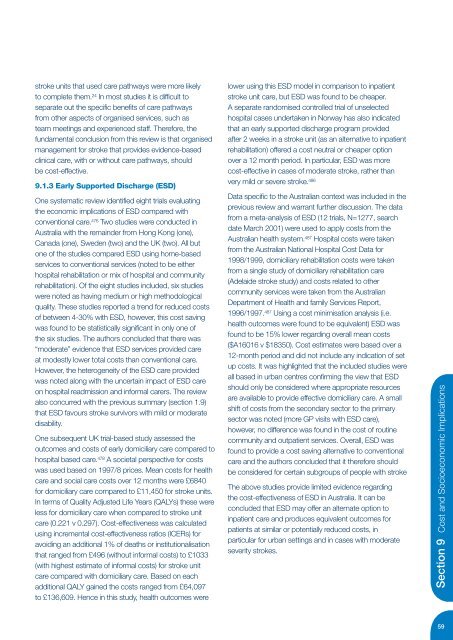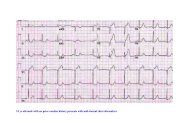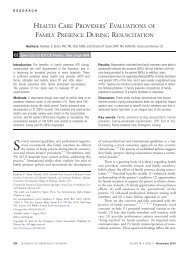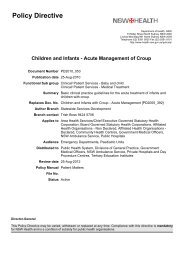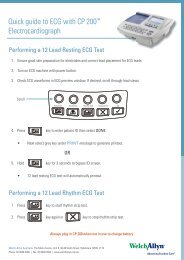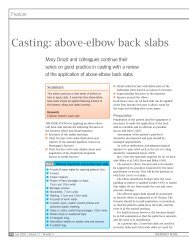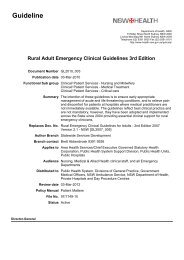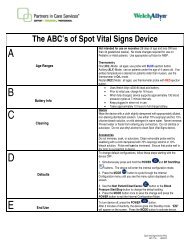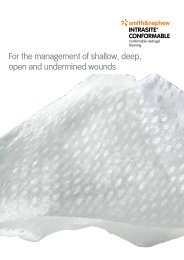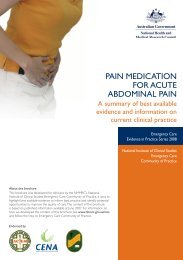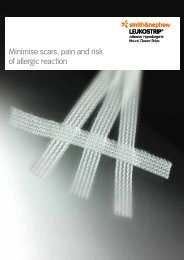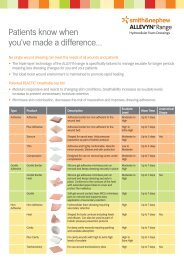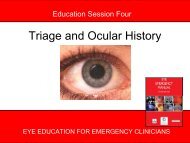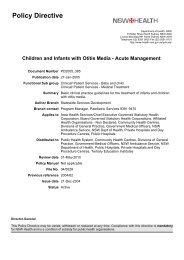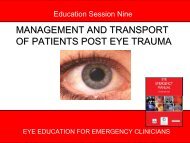Clinical Guidelines for Acute Stroke Management - Living on the EDge
Clinical Guidelines for Acute Stroke Management - Living on the EDge
Clinical Guidelines for Acute Stroke Management - Living on the EDge
Create successful ePaper yourself
Turn your PDF publications into a flip-book with our unique Google optimized e-Paper software.
stroke units that used care pathways were more likely<br />
to complete <strong>the</strong>m. 24 In most studies it is difficult to<br />
separate out <strong>the</strong> specific benefits of care pathways<br />
from o<strong>the</strong>r aspects of organised services, such as<br />
team meetings and experienced staff. There<str<strong>on</strong>g>for</str<strong>on</strong>g>e, <strong>the</strong><br />
fundamental c<strong>on</strong>clusi<strong>on</strong> from this review is that organised<br />
management <str<strong>on</strong>g>for</str<strong>on</strong>g> stroke that provides evidence-based<br />
clinical care, with or without care pathways, should<br />
be cost-effective.<br />
9.1.3 Early Supported Discharge (ESD)<br />
One systematic review identified eight trials evaluating<br />
<strong>the</strong> ec<strong>on</strong>omic implicati<strong>on</strong>s of ESD compared with<br />
c<strong>on</strong>venti<strong>on</strong>al care. 476 Two studies were c<strong>on</strong>ducted in<br />
Australia with <strong>the</strong> remainder from H<strong>on</strong>g K<strong>on</strong>g (<strong>on</strong>e),<br />
Canada (<strong>on</strong>e), Sweden (two) and <strong>the</strong> UK (two). All but<br />
<strong>on</strong>e of <strong>the</strong> studies compared ESD using home-based<br />
services to c<strong>on</strong>venti<strong>on</strong>al services (noted to be ei<strong>the</strong>r<br />
hospital rehabilitati<strong>on</strong> or mix of hospital and community<br />
rehabilitati<strong>on</strong>). Of <strong>the</strong> eight studies included, six studies<br />
were noted as having medium or high methodological<br />
quality. These studies reported a trend <str<strong>on</strong>g>for</str<strong>on</strong>g> reduced costs<br />
of between 4-30% with ESD, however, this cost saving<br />
was found to be statistically significant in <strong>on</strong>ly <strong>on</strong>e of<br />
<strong>the</strong> six studies. The authors c<strong>on</strong>cluded that <strong>the</strong>re was<br />
“moderate” evidence that ESD services provided care<br />
at modestly lower total costs than c<strong>on</strong>venti<strong>on</strong>al care.<br />
However, <strong>the</strong> heterogeneity of <strong>the</strong> ESD care provided<br />
was noted al<strong>on</strong>g with <strong>the</strong> uncertain impact of ESD care<br />
<strong>on</strong> hospital readmissi<strong>on</strong> and in<str<strong>on</strong>g>for</str<strong>on</strong>g>mal carers. The review<br />
also c<strong>on</strong>curred with <strong>the</strong> previous summary (secti<strong>on</strong> 1.9)<br />
that ESD favours stroke survivors with mild or moderate<br />
disability.<br />
One subsequent UK trial-based study assessed <strong>the</strong><br />
outcomes and costs of early domiciliary care compared to<br />
hospital based care. 478 A societal perspective <str<strong>on</strong>g>for</str<strong>on</strong>g> costs<br />
was used based <strong>on</strong> 1997/8 prices. Mean costs <str<strong>on</strong>g>for</str<strong>on</strong>g> health<br />
care and social care costs over 12 m<strong>on</strong>ths were £6840<br />
<str<strong>on</strong>g>for</str<strong>on</strong>g> domiciliary care compared to £11,450 <str<strong>on</strong>g>for</str<strong>on</strong>g> stroke units.<br />
In terms of Quality Adjusted Life Years (QALYs) <strong>the</strong>se were<br />
less <str<strong>on</strong>g>for</str<strong>on</strong>g> domiciliary care when compared to stroke unit<br />
care (0.221 v 0.297). Cost-effectiveness was calculated<br />
using incremental cost-effectiveness ratios (ICERs) <str<strong>on</strong>g>for</str<strong>on</strong>g><br />
avoiding an additi<strong>on</strong>al 1% of deaths or instituti<strong>on</strong>alisati<strong>on</strong><br />
that ranged from £496 (without in<str<strong>on</strong>g>for</str<strong>on</strong>g>mal costs) to £1033<br />
(with highest estimate of in<str<strong>on</strong>g>for</str<strong>on</strong>g>mal costs) <str<strong>on</strong>g>for</str<strong>on</strong>g> stroke unit<br />
care compared with domiciliary care. Based <strong>on</strong> each<br />
additi<strong>on</strong>al QALY gained <strong>the</strong> costs ranged from £64,097<br />
to £136,609. Hence in this study, health outcomes were<br />
lower using this ESD model in comparis<strong>on</strong> to inpatient<br />
stroke unit care, but ESD was found to be cheaper.<br />
A separate randomised c<strong>on</strong>trolled trial of unselected<br />
hospital cases undertaken in Norway has also indicated<br />
that an early supported discharge program provided<br />
after 2 weeks in a stroke unit (as an alternative to inpatient<br />
rehabilitati<strong>on</strong>) offered a cost neutral or cheaper opti<strong>on</strong><br />
over a 12 m<strong>on</strong>th period. In particular, ESD was more<br />
cost-effective in cases of moderate stroke, ra<strong>the</strong>r than<br />
very mild or severe stroke. 486<br />
Data specific to <strong>the</strong> Australian c<strong>on</strong>text was included in <strong>the</strong><br />
previous review and warrant fur<strong>the</strong>r discussi<strong>on</strong>. The data<br />
from a meta-analysis of ESD (12 trials, N=1277, search<br />
date March 2001) were used to apply costs from <strong>the</strong><br />
Australian health system. 487 Hospital costs were taken<br />
from <strong>the</strong> Australian Nati<strong>on</strong>al Hospital Cost Data <str<strong>on</strong>g>for</str<strong>on</strong>g><br />
1998/1999, domiciliary rehabilitati<strong>on</strong> costs were taken<br />
from a single study of domiciliary rehabilitati<strong>on</strong> care<br />
(Adelaide stroke study) and costs related to o<strong>the</strong>r<br />
community services were taken from <strong>the</strong> Australian<br />
Department of Health and family Services Report,<br />
1996/1997. 487 Using a cost minimisati<strong>on</strong> analysis (i.e.<br />
health outcomes were found to be equivalent) ESD was<br />
found to be 15% lower regarding overall mean costs<br />
($A16016 v $18350). Cost estimates were based over a<br />
12-m<strong>on</strong>th period and did not include any indicati<strong>on</strong> of set<br />
up costs. It was highlighted that <strong>the</strong> included studies were<br />
all based in urban centres c<strong>on</strong>firming <strong>the</strong> view that ESD<br />
should <strong>on</strong>ly be c<strong>on</strong>sidered where appropriate resources<br />
are available to provide effective domiciliary care. A small<br />
shift of costs from <strong>the</strong> sec<strong>on</strong>dary sector to <strong>the</strong> primary<br />
sector was noted (more GP visits with ESD care),<br />
however, no difference was found in <strong>the</strong> cost of routine<br />
community and outpatient services. Overall, ESD was<br />
found to provide a cost saving alternative to c<strong>on</strong>venti<strong>on</strong>al<br />
care and <strong>the</strong> authors c<strong>on</strong>cluded that it <strong>the</strong>re<str<strong>on</strong>g>for</str<strong>on</strong>g>e should<br />
be c<strong>on</strong>sidered <str<strong>on</strong>g>for</str<strong>on</strong>g> certain subgroups of people with stroke<br />
The above studies provide limited evidence regarding<br />
<strong>the</strong> cost-effectiveness of ESD in Australia. It can be<br />
c<strong>on</strong>cluded that ESD may offer an alternate opti<strong>on</strong> to<br />
inpatient care and produces equivalent outcomes <str<strong>on</strong>g>for</str<strong>on</strong>g><br />
patients at similar or potentially reduced costs, in<br />
particular <str<strong>on</strong>g>for</str<strong>on</strong>g> urban settings and in cases with moderate<br />
severity strokes.<br />
Secti<strong>on</strong> 9 Cost and Socioec<strong>on</strong>omic Implicati<strong>on</strong>s<br />
59


